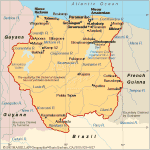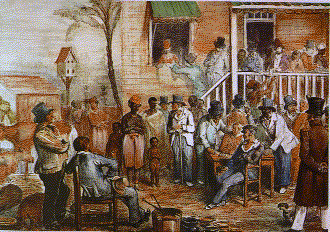 |
 |
| Juliana is IMC's ICQ friend from Suriname. Here are some
information about Suriname.
Juliana IMC nin ICQ'dan Surinam'lı arkadaşıdır. Aşağıda Juliana'nın ülkesi Surinam ile ilgili bilgi bulacaksınız. |
 |
The first Europeans settled in Suriname in 1650. Most of them did not make it long. Indians and diseases decreased their numbers. The first English settlers were sent by Lord Willoughby, the governor of Barbados. The Zealander Abraham Crijnsen invaded Willoughby's settlement and after the peace treaty of Breda (1667) the Dutch gained Suriname but lost their colony in North America (New York).
It was not cheap to to protect the plantations in Suriname from attacks from Indians and hostile Europeans. Therefore the Zealanders sold the colony to the Dutch trade company West Indische Companie and the family Van Sommelsdijck in 1683. The head of the family, Cornelis van Aerssen heer van Sommelsdijck, became governor of Suriname. Sommelsdijck improved the security of the plantations. He was killed in a mutiny in 1688.
After a troublesome period at the end of seventeenth and the begin of the eighteenth century, agriculture flourished in Suriname in the first half of the eighteenth century. Most of the work on the plantations was done by African slaves. The slaves outnumbered the Europeans at the plantations. They were not treated very well: in the Caribbean region Suriname had a bad name with respect to slave treatment. Many slaves fled into the jungle. These refugees were named Maroons. Often they returned to attack the plantations.
The Governors Mauritius and Crommelin succeeded in making peace treaties with some marron tribes. Still there were tribes that attacked the European settlements. One of the best known marron tribe leaders of the second half of the eighteenth century was Boni. The French Revolution of 1789 led to to abolition of slavery in Suriname's eastren neighbor French Guiana which shocked the Surinamese plantation owners.
Suriname was occupied by the English in 1799 after the Dutch became a part of France (Bataafse Republiek). Apart from the period between 1802 and 1804 Suriname remained English territory until 1816. The English abolished slave trade in 1808 and improved the position of the Surinamese slaves. After the defeat of Napoleon The Netherlands got back their colony in South America.
On July 1, 1863 the Dutch were the last Europeans to abolish slavery. Ten years before that date, the owners of the plantations had started with importing labourers from other continents. The first were Chinese people from Indonesia. Some years before them some Dutch farmers from Groningen were taken to the country to start small farms. These attempts to save the agricultural importance of Suriname were no success: half of the Dutch farmers died within a year and the Chinese immediately left the plantations after a 5-year obligatory working period.
The Surinamese slaves were not completely free from 1863. They had to
work another ten years at the plantations. The only difference was that
they got some kind of payment during the years 1863-1873. The former African
slaves left the plantations in 1873. The were replaced by Hindustani labourers
from India (most from around Calcutta). Like the Chinese, these people
were required to work on the plantations for some years after which they
could return to India or prolong their contract. About 37,000 Hindustanis
were
imported to Suriname before a movement in India led by Mahatma Ghandi stopped
this immigration in 1916.
 |
The Indians labourers were replaced by people from another Dutch colony: Indonesia. About 33,000 Indonesian came to Suriname between 1900 and 1940. Like the Hindustanis most of them left the plantations after fulfilling their contract and started a small farm. The plantations lost their importance for the economy of the country. For example, the number of sugar plantations decreased from 80 in 1863 to 4 in 1940.
In the first half of the twentieth century the exploration of other natural resources of Suriname started. Gaining rubber, gold and bauxite became important for the economy of Suriname. The American bauxite company ALCOA got a claim on a large part of the interior of Suriname for a period of forty years. The bauxite gained by Surinamese daughter company of ALCOA, SURALCO, was probably Suriname's most important contribution to to allied forces during World War II. Aluminium, made from bauxite, was very important for constructing airplanes.
Suriname was on its own during the German occupation of The Netherlands (1940-1945). At the time The Netherlands got occupied, the Germans had a large ship, the Goslar, in Paramaribo. The captain of the ship managed to sink the ship before it could be taken over by the Surinamese authorities. The remains of the ship still lie in the harbor of Paramaribo. After the war the political status of the Dutch colonies was changed.
The Dutch had succeeded in keeping the different ethnical groups of Suriname apart. The results of this can be seen in the political parties which emerged in Suriname around 1950. The most important parties were NPS (later NPK: mostly creoles from African origin) and the VHP (mostly Hindustanis).
After the 1973 elections the NPK-government suddenly started to negotiate with The Netherlands about the independence of Suriname. The negotiations succeeded. Suriname became independent at November 25, 1975 and the Netherlands agreed to support the young country for ten years with a total amount of four billion guilders. Dr Johan Ferrier became the first president of the independent Suriname and the first prime minister was Henk Arron. Many Surinamese did not trust an independent Suriname and fled to The Netherlands.
After short period of political instability at the end of the seventies a group of sixteen young militaries overtook the government in 1980. This revolution was welcomed by the population that expected that the new government installed by the army would end corruption and improve the life standard in Suriname. The Dutch initially accepted the new government. However, the cooperation between Suriname and The Netherlands collapsed when 15 political opponents were killed by the army at 8 december 1982.
Without the Dutch development money a lack of foreign currency occurred in Suriname and the inflation rate started to rise. A first attempt to reinstall democracy in 1987 ended in 1990 when the army led by Desi Bouterse sent home the government. There were general elections in 1991 after which drs Ronald Venetiaan was chosen as president of Suriname.